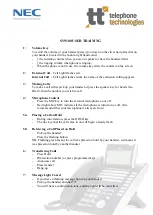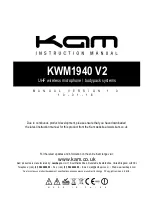
13
English
4) Point the IR sensor (15, 23) of the wireless
microphone / pocket transmitter towards the IR
window (6) on the receiver . The distance must
not exceed 1 .5 m . Make sure that there are
no obstacles between the sensor and the IR
window .
Keep the button ACT (7) pressed for a few
seconds until the display backlight of the wire-
less microphone or the pocket transmitter has
been activated . Thus, the wireless microphone
or the pocket transmitter and the receiver have
been set to the same channel . The display (14
or 22) shows the channel number .
5 Operation
1) Put the receiving antennas (1) in a vertical
position .
2) Switch on the receiver with the POWER switch
(9) first . The LED AF (4) flashes twice . The display
(3) shows the transmission channel adjusted .
If one of the reception LEDs RF (5) lights up
while the wireless microphone
1
or the pocket
transmitter
2
is still switched off, interfering sig-
nals or signals from another wireless system are
received . In this case, adjust a different channel
(
☞
chapter 4 .4) .
3) To switch on the pocket transmitter, set the
switch (21) to the position ON . To switch on the
wireless microphone, set the switch (16) to the
upper position . For transmitting sound, set the
switch on the wireless microphone to the upper
stop or set the switch on the pocket transmitter
to ON . In the mid-position, the transmitter is on,
but the microphone signal is muted .
After switching on, the backlight of the
display (14, 22) lights up for a few seconds .
The display shows the channel adjusted and
the battery status .
BATT
BATT
BATT
full discharged
Note:
Replace the batteries when the indication BATT
starts flashing .
4) On the wireless microphone, adjust the trans-
mitting power with the switch POWER (19) in
the battery compartment .
– upper position HI = high power for a long
range, but reduced battery life
– lower position LO = low power for a long life,
but reduced range
5) When the transmitter (wireless microphone or
pocket transmitter) is switched on, one of the
reception LEDs RF A or B (5) lights up on the
receiver to indicate which receiving part sup-
plies the best signal . If none of them lights up,
please check:
a Have the transmitter and the receiver been
set to the same channel?
If different channels are indicated on the
receiver and on the wireless microphone /
pocket transmitter, proceed with step 4 of
chapter 4 .4 .
b Are the batteries of the transmitter dis-
charged?
c Has the wireless microphone been set to a
low transmitting power?
d Is the distance between the transmitter and
the receiver too long?
Range:
TXS-611 / -631 / -636SET : approx . 30 m
TXS-616SET : approx . 50 m
e Is the reception disturbed by metal objects in
the transmission path?
f Is it possible to improve the reception when
you turn the receiving antennas (1)?
g Has the interference suppression been set too
high with the control SQUELCH (13)?
(
☞
step 7)
6) Switch on the following audio unit or advance
the corresponding mixer control . Speak/sing
into the microphone and match the output level
of the receiver to the input of the following unit
with the control VOLUME (12) .
On the pocket transmitter, adjust the gain
for the microphone connected with the control
GAIN (27) on the rear side: If the volume of the
microphone signal is too high and the signal is
distorted, turn back the control with a small
screwdriver . If the volume of the signal is too
low, however, the signal-to-noise ratio is poor;
advance the control accordingly .
7) With the control SQUELCH (13), adjust the
threshold value for response of the interfer-
ence suppression . The interference suppression
will mute the receiver during pauses in speech
or vocals when interfering signals are received
and their levels are below the threshold value
adjusted . A high threshold value, however, will
also reduce the range of the microphone sys-
tem: If the power of the radio signal falls below














































